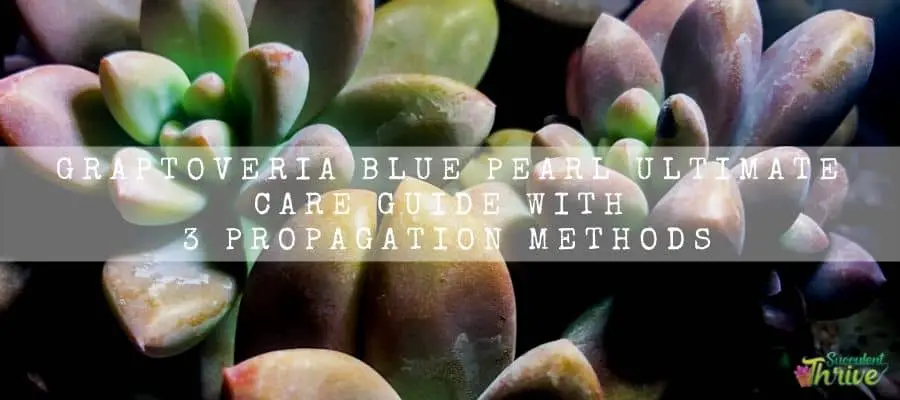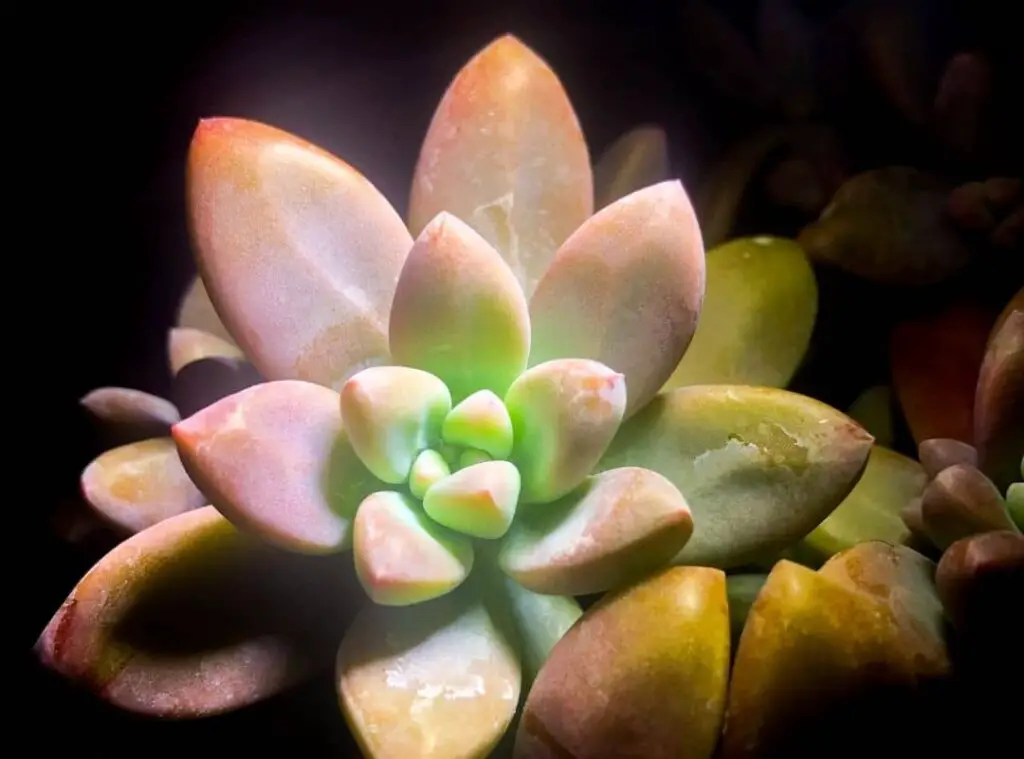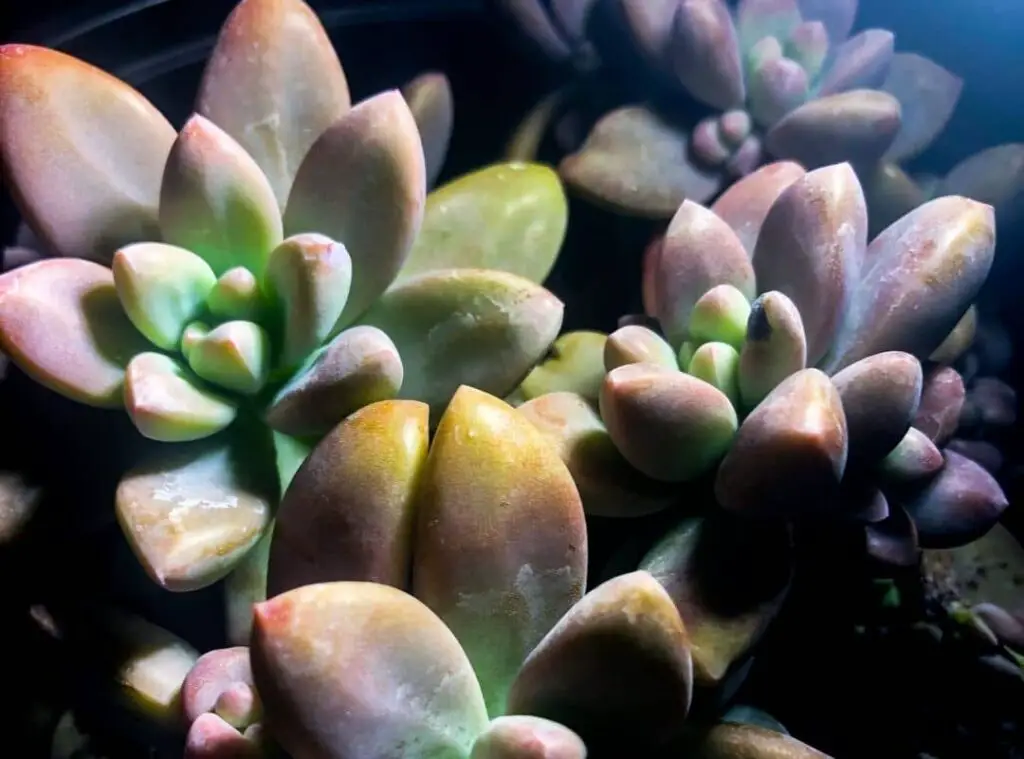Graptoveria blue pearl is a beautiful succulent belonging to the Graptoveria plant group. This Graptoveria is a hybrid of famous Echeveria and Graptopetalum.
Therefore Graptoveria succulents inherit all the good features of Echeveria and Graptopetalum.
Graptoveria blue pearl usually contain blush violet bronze when you expose them for bright sunlight and colder temperatures. They would be handy picks for rock gardens. Alternatively, you could use them as a filler plant.
You could pinch them quite often and that will make them look bushier. You need to grow them in a porous soil which is well draining.
In addition to that you need to expose them for bright sunlight along with good aeration. They would require a thorough watering when their soil is dry. Avoid exposing them from frost.
Let’s find out details about Graptoveria blue pearl succulent care in this article

How do I identify a Graptoveria blue pearl?
You could identify the Graptoveria blue pearls by looking at their leaves. They are a warm ruddy to blue in color.
Their leaves would be slender when compared with the other succulents. The slender leaves give them the effect of blue starfish.
You could mainly spot this pattern when you grow them along with other plants.
Size
Blue pearl plants would rise to 7-8 inches in height. Further they would be 9-11 inches wide.
Growth
These plants are renowned as a slow growing set of plants.
One look care guide
| Botanical Name | Graptoveria blue pearl |
| Common Name | blue pearl |
| Plant Type | Succulent |
| Mature Size | 7-8 inches in height. 9-11 inches widespread. |
| Sun Exposure | Sull sunlight to partial sunlight |
| Soil Type | Well-draining |
| Soil pH | 5.6-7.8 (Pls check this) |
| Bloom Time | Summer |
| Flower Color | lavender |
| Hardiness Zones | 9a |
| Toxicity | Non-Toxic |
| Average price | 10 USD |
How do you take care of a Graptoveria blue pearl?
Light Requirement
They would require bright sunlight to thrive well. Ideally it has to be 6-7 hours of bright sunlight daily. In case if they grow light starved, they will be etiolated.
That means they would stretch towards a lighting source where they can absorb enough sunlight.
Unfortunately, if your beloved blue pearl plant goes through this condition, it is very unlikely that they would regain their rosette shape. You will have to behead them and start growing them freshly.
If you are growing them indoors best is to place them near a bright sunny window. You could be tactful here by rotating your plant every few days so that it will make sure that your whole plant will get adequate sunlight equally.
Even though blue pearl plants are fond of sunlight, refrain from exposing these plants to scorching sun directly from a shady place.
Best is to slowly accustom them to bright sunlight. Unless it would cause sunburns in the plant.
When there are sunburns in the plant, you could see how they form brown calloused patches on their foliage.
What is more concerning is that, when your pearl plant has got sun burns, those patches will remain there forever.
Further they will not get their usual color as well. Hence, avoid creating sunburns in the plant.
Temperature and humidity
Best temperature to grow them would be 65 °F to 75 °F (18 °C to 24 °C). They cannot withstand the colder weather conditions, particularly the temperatures lower than 30 °F (-1 °C).
In terms of humidity, they would prefer to grow in natural room humidity levels. If you expose them for high humidity levels, that will create root rots in your plant.
As such refrain from placing your plants in high humidity places such as in bathrooms. You could consider growing them under a fan as the air circulation would be benefited from that.
Is it cold hardy?
Blue pearl plants are not cold hardy plants.
USDA hardiness zone
These plants would prefer to thrive in USDA hardiness Zone 9a (20-25° F)
Watering Requirement
Blue pearl plants’ water requirement is the same as most other succulents. These plants consist of thick leaves which could store water in them during drought seasons.
When it comes to watering them during summer, you could consider watering them once a week. However, you need to water them, only when their soil is dry.
Avoid keeping these plants stranded in waterlogged conditions since that would badly impact on the plant.
On another note, if your blue pearl plant is running short of water, you could spot their lower leaves wrinkled.
When you have to water these plants in winter, you could limit watering them to once every three to four weeks. That will avoid any potential root rot in the plant.
In addition to that, you need to be mindful to water these plants at their base only.
Avoid pouring water into their rosettes or on their leaves since that would lead to rot in the plant.
In case if you unintentionally drop some water on those areas, you could simply wipe them off with a tissue.
Soil Requirement Type / pH
You need to make sure that you are growing the blue pearl plants in a well-draining and a porous soil mix.
Flowering and Fragrance
Blue pearl plants would bloom with light lavender-colored flowers during the summer season.

Pot size Potting and Repotting
You could grow the blue pearl plants in terracotta pots which have enough draining holes. That will avoid retaining any excess water in the pot and consequently avoid the root rots as well.
Further you need to consider repotting them when you freshly purchased them from nursery or from the stores.
You simply have to take it off from the pot and get rid of the older soil around the roots. After that you could replant them in a fresh well-draining soil mix.
You could repot them once every few years. Further you do not need to change the containers since they are a slow growing set of plants.
Further when you repot, if you wish you could transplant them in a slightly larger pot. If you use a much larger pot, it will create waterlogged conditions for the plants and could lead to rot.
Where to Plant
Blue pearl plants are not cold hardy plants. As such refrain from growing them in places where they expose for colder weather conditions.
Best is to plant them in a container which you could shift indoors.
Fertilizer and time of year
Usually, these plants are not dependent on fertilizers. However, always it is always better to feed them during their growing season.
However, avoid over feeding them though. If you overfeed them, it would cause burns in the leaves and in plant shock as well.
As such best is to apply a diluted chemical fertilizer. Alternatively, you could consider using a liquid fertilizer.
Apart from that you may use organic fertilizers as well. For example, you could use compost manure.
You could obtain them from cows, hens and even from sheep. Moreover, you could use worm castings as well, they are hummus and would be beneficial in balancing the ph. of the soil.
Further it would help to better the aeration as well.
Dormancy
They are summer dormant plants
Can be toxic to pets
Blue pearl plants are nontoxic for both pets and for humans.
Common bugs and illness issues
If you do not expose your blue pearl plant for adequate sunlight, they would tend to grow leggy. Further you could spot gaps between the leaves.
These are generally sunlight loving plants. As such, whenever you spot them becoming taller and leggy, you need to immediately shift them to a brighter place.
What is more concerning is that you cannot fix the etiolated plants and it will not be possible for them to regain their rosette shape.
However, you could use the etiolated plant parts to propagate if you wish to make new plants. In addition to that, you could see these plants bending towards a certain direction when they lack adequate sunlight.
Ideally you need to rotate the plant once every few days so that the whole plant could gain sunlight in equal amounts.
If these plants grow light starved, they will tend to use their vibrant color in their foliage. To remedy this, you could consider growing them under a grow light, particularly if you are growing them indoors.
Moreover, you could come across situations where the bottom leaves of your blue pearl would be dying.
Usually, the succulent leaves in the center grow by absorbing nutrients from the leaves in the bottom part of the plant.
As such you could anyway spot some dry leaves in the bottom of the plant and they will naturally fall off on the ground.
Further chances are that your blue pearl succulent would turn yellow and mushy too. You will come across such situations particularly if you have over-watered your blue pearl plants.
You could see how the leaves in the base of the plant are turning mushy and yellow in color.
Further you could spot their stems turning black or brown too. Finally, you could see how they gradually lose their rosette shape too.
Root rot could be the worst problem which could happen for your blue pearl plants.
You could commonly spot this problem and unfortunately it is very unlikely that you could fix it despite what you do to remedy it. Chances are that it could even kill your plant.
As such when watering, you need to always make sure that you are allowing the soil to become dry and only after that water them.
Further check whether you have grown them in a well-draining soil mix and whether your pot has adequate draining holes too.
If the root rot has occurred on a significant level, it is very unlikely that you could save the plant. In that case best is to propagate them.
Special Care tips
In terms of taking care of the Graptoveria blue pearls, you do not really have to do anything special.
These are slow growing plants and you do not have to groom them a lot. Having said that, if you wish to keep its aesthetic beauty and to maintain its attractiveness, I recommend you prune the plants.
You could consider doing that, particularly if you spot any signs of them becoming etiolated.
In addition to that, you may pluck off whatever the wilted or older leaves of the plant. Particularly if you see any signs of fungal infections, you need to immediately get rid of them.
Generally, these plants would start shedding their leaves, as such you need to remove those debris.
That will consequently help you to keep it clean and tidy. Unless it would be a great breeding spot for bugs.

How do you propagate a Graptoveria blue pearl?
There are mainly three ways of conducting the propagation of the Graptoveria blue pearl. They by using their leaves, cuttings and by using offsets
Graptoveria blue pearls propagation by leaves?
You could propagate the Graptoveria blue pearls by using their leaves. you could specially try this method on the etiolated blue pearls plants which have lost their rosette type.
You could consider growing them so that you could grow new attractive plants.
You have to choose a healthy leave and carefully separate that leave from the succulent.
Then place the leaves on a dry place to dry. After two days you can plant the leaves in a suitable soil mix.
Graptoveria blue pearls propagation by cuttings?
To do that, you simply have to obtain 1.5 inches cuttings using sterilized and clean garden shears.
When you obtain the cuttings, you need to make the cutting below the rosette stem. After that leave those cuttings become callous for a couple of days and plant them in a well-draining soil mix. Skip watering them for a week’s time.
Expose your specimen for bright and indirect sunlight.
Graptoveria blue pearls propagation by offsets?
Blue pearl plants usually form offsets (pups) and they usually pop out from the base of the plant. Do not remove the offsets as soon as they pop out from the plant.
Instead, you need to wait until those become ¼ of the mother plant size and then remove. Once they are calloused you could plant them in a new pot.
Skip watering them for about a week. That will allow them to settle in the new growing conditions. After some time, you could provide them bright indirect sunlight and water them as appropriate.
Graptoveria blue pearl plant benefits
- They could be beneficial as houseplants.
- Blue pearls can purify the air
- Would be effective in improving the humidity of the house
- They will help you to stay focused
Related questions
How do you care for a Graptoveria Blue Pearl?
Make sure that you grow these succulents under bright sunlight. Grow them in a well-draining soil mix.
Further, you should water them thoroughly but infrequently. That will avoid rots in the plant. Further, always go ahead with pots with ample draining holes.
Is Graptoveria edible?
Blue pearl plants are not edible although they are non-toxic for pets and for humans. As such you should not let the kid consume any parts of this plant.
Read Next : Graptosedum Alpenglow Ultimate Care And 4 Propagation Methods
